Originally posted September 14th, 2004, by rob-ART morgan, mad scientist
Updated June 22, 2005, with Razer Diamondback
NOTE: Since we last updated this article, Apple has released the Mighty Mouse in both wired and wireless versions. Finally a multi-button mouse design from Apple with a small four way scroll ball my friends call a "titty." A full report is on our "to do" list.
It's been four years since Apple introduced their optical "Pro Mouse." A year ago this month, they introduced the (Bluetooth) Wireless Mouse (and keyboard). Apple has stubbornly held to a one button mouse. As I write this, there are many capable alternatives to the Apple Wireless Mouse. Most of them offer better response and accuracy. All of them offer more button options and superior ergonomics. A well designed mouse can make your Mac work faster because it's helping you point, select, click, and drag more efficiently.
We've listed our picks for the most significant mice for the Mac.
| BLUETOOTH |
|
 |
Apple Wireless Mouse
One button; No scroll wheel; Attractive clear on white plastic; Available matching Bluetooth keyboard; Works with righties and lefties; Reconnects to Bluetooth without button push; Clever battery saving "trap door" |
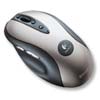 |
Logitech MX900
Eight buttons plus scroll wheel; Available matching Bluetooth keyboard; Reconnects to Bluetooth without button push; Battery charging cradle for NiMH batteries. My favorite Bluetooth mouse. |
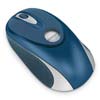 |
Kensington Pilot Mouse
Two buttons plus scroll wheel; ribbed soft grips on the sides; Wider than the others tested; Works with righties and lefties; Requires a button push to reconnect to Bluetooth (eek!) |
 |
Macally BTmouseJR
Two buttons plus scroll wheel; Lighter and smaller than the other Bluetooth mice; great for traveling with your PowerBook; Requires a button push to reconnect to Bluetooth (eek!) I take this one when I travel with my PowerBook. |
| RF wireless |
|
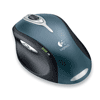 |
Logitech MX1000
It uses a new laser sensor technology that's reportedly 20 times more sensitive than optical. Features include 8 programmable buttons, 4-way tilt scroll wheel, quick recharge cradle and signal sender, battery charge status indicator. Only requires A/C for charging batteries. |
 |
Kensington StudioMouse Wireless
Three buttons plus unique scroll sensor (instead of wheel); soft grips on the side; dual AAA batteries recharged in cradle. |
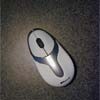 |
Targus Ultra Mini Wireless
Two buttons plus scroll wheel; jumpy cursor; world's smallest mouse; doubles as a presentation controller; claimed range of 50 feet (versus Bluetooth's 30 foot range); good Powerbook or iBook companion |
| USB cabled |
|
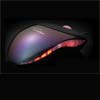 |
Razer Diamondback
My new favorite cabled USB optical. Features 1600 dpi ultra precision, 5.8 megapixels per second response, and 16 bit data path. This seven button mouse is a favorite with Windows PC gamers though Mac drivers are now available. Choose from 3 glowing colors. |
 |
Logitech MX510
Eight buttons plus scroll wheel; Same MX Optical Engine as the MX900; for right handed users. |
BLUETOOTH ANALYSIS
I liked the look, feel, and performance of the Logitech MX900 better than any of the other Bluetooth mice. According to Logitech, it "features an improved version of our already-amazing MX Optical Engine, which combines high resolution with high frame rates to deliver the best in mouse performance. This breakthrough 800-dpi sensor now captures an incredible 5.8 megapixels every second and is able to track up to 15 Gs of acceleration." Kensington says their Pilot Mouse has "unmatched acceleration control and ultra-high speed tracking," but gives no specs. The only thing with better specs than the MX900 is the Razor Diamondback USB corded optical mouse.
Both the MX900 and Pilot Mouse were as precise and responsive as any mouse I've used with the possible exception of the MX510, which is the 46 grams lighter cousin to the MX900 -- since it doesn't have to carry around dual AA batteries -- due to the fact that it's a USB optical mouse with a cable.
Eight programmable buttons on the MX900 may seem superfluous for to Mac users since there's no Logitech Mac driver that works with it. Not to worry. If you only use the left button, right button, and scroll wheel, you don't need software.Exception: Some applications "know" about the MX900. I went to the control settings of several 3D games. They recognized anywhere from 3 to 7 of the programmable buttons of the MX900. For apps that don't recognize the extra buttons, I suggest you program them using either USBOverdrive, GamePad Companion or ControllerMate. This applies to any mouse device that doesn't respond to the manufacturer's Mac drivers (or lack of them).
The most annoying "feature" of Bluetooth mice is the battery conservation mode. Whether your Mac goes to sleep or not, most manufacturers put their Bluetooth mouse to "sleep" after a short period of disuse. Sometimes, you'll even see the "lost connection" message on your screen. The only way to reconnect or "re-discover" the mouse is to press one of the buttons. That can have unpredictable (and sometimes unwanted) results, depending on where you left the cursor pointing.
Thankfully, MX900 doesn't sleep. It's always polling the "mother ship" so it's always ready when you are. The down side is that "insomnia" can use up the batteries faster. Never fear. Logitech includes two AA size NiMH batteries along with a wireless hub (for Windows PCs only) which doubles as a battery recharging cradle. When you leave your workstation, just drop the MX900 in the hub while you are gone.
Apple's Wireless Bluetooth Mouse is the only other Bluetooth mouse that reconnects to the Bluetooth port without a button push. It addresses the battery useage issue by giving you a "trap door" to close when not using the mouse. That's especially useful when transporting the mouse.
If you don't have Bluetooth capability built into your Mac, you can get a Bluetooth receiver dongle that plugs into your USB port -- assuming you have USB.
RADIO FREQUENCY (RF) ANALYSIS
Oddly enough, Logitech's top of the line MX1000 use RF wireless technology instead of Bluetooth (as used by the MX900). The biggest downside to RF mice used to be the required power supply, power cable, and USB cable (for sending unit). The MX1000 only requires the cradle to be plugged into the A/C source if you are using it to charge up the mouse's battery -- which only has to be done occasionally, since it uses less power than the Bluetooth mice.
The MX1000's laser sensor seems to be more precise than the optical sensor on most optical mice. But that's a subjective judgement. The mouse feels "right" to the right hand. Though the heaviest mouse we tested, it glides very nicely on the teflon pads. The biggest advantage over the MX900: The Mac drivers work on all G4 based Macs, enabling you program the 8 buttons plus tilting scroll wheel. For some reason, the driver won't load on the Mac, but you can program it for your Mac using either USBOverdrive, GamePad Companion or ControllerMate.
My favorite use of the tilt wheel is moving sideways through spreadsheets.
USB CABLED ANALYSIS
I like the Logitech MX510 a lot but my new favorite is the Razer Diamondback. I liked it so much I got two of them. I think I'm developing a mouse fetish, but the lightness and preciseness of the Razer makes my Power Mac and PowerBook seem faster than ever.
(NOTE: Since writing this article, the Razer DiamondBack 3G was released with an even higher resolution than the DiamondBack (1600 vs 1800). We've bought four of them for our lab. Our favorite LED glow color is red. We like the 2000dpi Copperhead even better but it has issues with the Mac.)
WEIGHTY ISSUES
When is a mouse too heavy? The Bluetooth mice tend to be on the heavy side, due to the required dual AA batteries. However, thanks to teflon "feet" and slippery cloth mouse pads, they can feel as responsive as lighter mice.
Here's the stats on the mice we were able to weigh:
Logitech MX1000 = 168 grams (with batteries)
Kensington Pilot Mouse = 167 grams (w/AA batteries)
Logitech MX900 = 165 grams (w/AA batteries)
Logitech Dual Optical = 126 grams
Apple Wireless Mouse = 123 grams (w/AA batteries)
Logitech MX510 = 121 grams
Macally BTmouseJR = 116 grams (w/AA batteries)
Kensington StudioMouse RF Wireless = 110 grams (w/AAA batteries)
Razer DiamondBack = 91 grams
Kensington StudioMouse = 86 grams
Apple Pro = 85 grams
Macally iOptiJr = 62 grams
Targus Ultra Mini Wireless = 62 grams (w/AAA batteries)
Swann OptiGlo Mini Mouse = 45 grams (world's lightest mouse)